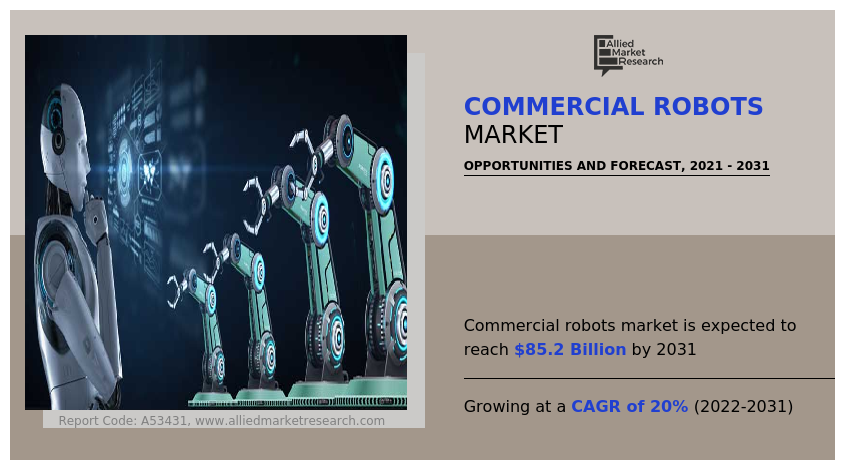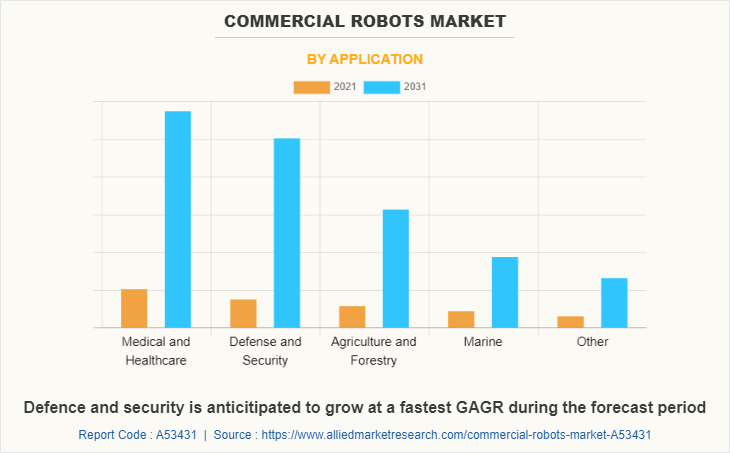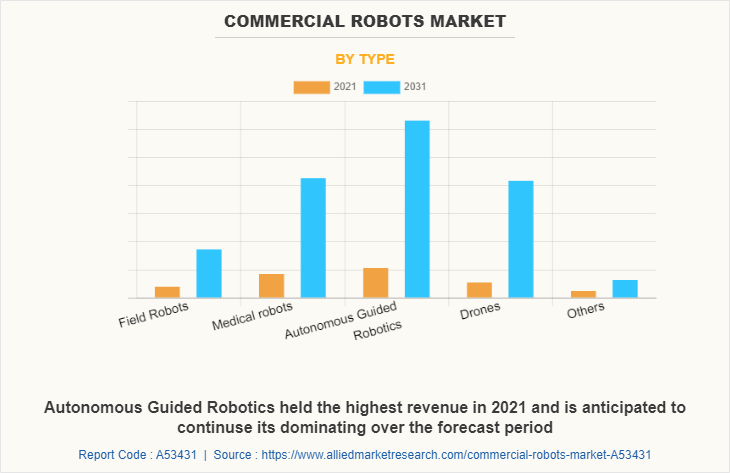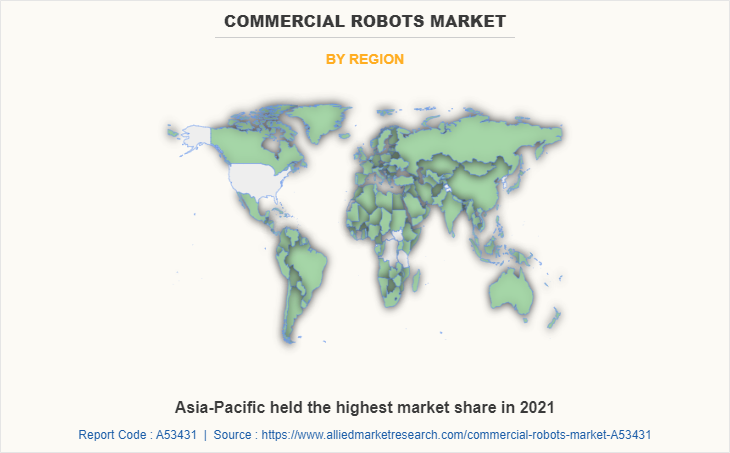Commercial Robots Market Insights, 2031
The global commercial robots market was valued at USD 15.2 billion in 2021, and is projected to reach USD 85.2 billion by 2031, growing at a CAGR of 20% from 2022 to 2031.
Commercial robots are devices used by a business for the purpose of replicating, assisting, or substituting a human’s actions. Commercial robots are distinct from consumer or personal robots that may handle tasks in the home, such as automated floor cleaning. Some robots, such as drones, have both personal and commercial uses.

The demand for commercial robots has increased because of the continuing shift from manual to automated processes, which is the main growth driving factor of the market. The synchronization of management, production, and control is critical to the effective running of industrial workflows. Commercial robots are becoming increasingly essential since they facilitate procedures and improve workflow accuracy and efficiency. The growth of small companies, more investment in automation, and strict government laws on management of hazardous chemicals and products are driving the demand for these robots. Similarly, industrial robots help in the carrying of heavy payloads during the production of automobiles and machine customization. The introduction of smart factories expands the market's potential.
The cost of purchasing market equipment and using the services given by the world's major participants is rather high. Small and developing companies are unable to purchase commercial robots and operate them across several departments and industry verticals. These factors are predicted to pose as major restraints in the commercial robots market growth.
The development of the commercial robots sector will also be driven by the need for increased productivity to support GDP growth. Robots, in most cases, augment human potential, by supporting humans in their activities, increasing overall productivity, and driving economic growth. Another factor expected to drive the commercial robot industry forward is that there are still lots of risky activities that can represent a risk to people, many of which can already be done by robots. Experts say that robots will take over the dull, the dirty, and dangerous jobs for humans. These factors are anticipated to boost the market growth in the upcoming years.
The key players profiled in this report include Northrop Grumman Corp., Kuka AG, iRobot Corporation, Yaskawa Electric Corporation, Omron Adept Technologies Inc., Honda Motor Company Limited, 3D Robotics Inc., Alphabet Inc., Accuray Inc., and AeroVironment Inc.
The global commercial robots market is segmented on the basis of type, application and region. By type, the market is sub-segmented into field robots, medical robots, autonomous guided robotics, drones, and others. By application, the market is classified into medical & healthcare, defense & security, agriculture & forestry, marine, and other. By region, the market is analyzed across North America, Europe, Asia-Pacific, and LAMEA. The commercial robots market is segmented into Application and Type.

By application, the medical & healthcare sub-segment dominated the global commercial robots market share in 2021. Commercial robots are utilized for a variety of domesticated tasks including, public service, patient monitoring, and other similar activities in healthcare institutions as well as home-based patient care. For example, in the first part of 2020, a hospital in Chennai, India, deployed service robots to deliver food and medications to COVID-19 patients. As a result, the huge increase in usage of these robots is predicted to drive market expansion in the coming years.

By type, the autonomous guided robotics sub-segment dominated the market in 2021. Autonomous guided robotics systems help to move and transport products in production facilities, warehouses, and distribution centers without the requirement of a fixed conveying system or operator involvement. It uses configurable guide paths to optimize storage, picking, and transport tasks in a premium space environment. The automatic guided vehicle systems (AGVs) were mostly wired (attached to the surface) and hence somewhat rigid as well as costly to install. But, companies like Fetch Robotics have recently produced more adaptable and intelligent AGVs that can make judgements in scenarios they have never experienced before. This adaptability can result in a variety of benefits, including decreased accidents, increased production, and cheaper costs. These are predicted to be the major factors affecting the commercial robots market size during the forecast period.

By region, Asia-Pacific dominated the global market in 2021 and is projected to remain the fastest-growing sub-segment during the commercial robots market forecast period. Asia-Pacific is expected to have significant growth because of the region's growing industrial manufacturing levels of automation and the improvement of technology. The Asia-Pacific market is driven by the sizeable and influential economies of Japan, China, and India. In addition, increasing government initiatives in the manufacturing sector and increased focus on economic diversification in developing nations are the two essential growth drivers boosting industrial automation. The most promising component driving the market's significant expansion over the projected period in the region can be shown to be the growing commercial robot density across the regional market.
Impact of COVID-19
- COVID-19 has negatively impacted various industries such as automotive that has led to a drastic decline in automotive sales. As commercial robots is widely used in automotive manufacturing, and there was significant reduction in the commercial demand globally.
- The COVID-19 pandemic forced many companies in the global commercial robots market to halt business operations for a short term to comply with new government regulations to curb the spread of the disease. This halt in operations directly impacted revenue flow of the global commercial robots industry.
- Economic slowdown has affected the setup of new commercial robots projects across the world as majority of government fundings were diverted towards construction and manufacturing sector owing to rapid spread of the COVID-19 virus, impacting the market to the great extent.
Key Benefits for Stakeholders
- This report provides a quantitative analysis of the market segments, current trends, estimations, and dynamics of the commercial robots market analysis from 2021 to 2031 to identify the prevailing commercial robots market opportunities.
- The market research is offered along with information related to key drivers, restraints, and opportunities.
- Porter's five forces analysis highlights the potency of buyers and suppliers to enable stakeholders make profit-oriented business decisions and strengthen their supplier-buyer network.
- In-depth analysis of the commercial robots market segmentation assists to determine the prevailing market opportunities.
- Major countries in each region are mapped according to their revenue contribution to the global market.
- Market player positioning facilitates benchmarking and provides a clear understanding of the present position of the market players.
- The report includes the analysis of the regional as well as global commercial robots market trends, key players, market segments, application areas, and market growth strategies.
Commercial Robots Market Report Highlights
| Aspects | Details |
| Market Size By 2031 | USD 85.2 billion |
| Growth Rate | CAGR of 20% |
| Forecast period | 2021 - 2031 |
| Report Pages | 280 |
| By Application |
|
| By Type |
|
| By Region |
|
| Key Market Players | iRobot Corporation, Omron Adept Technologies Inc., Honda Motor Company Limited, 3D Robotics Inc., Accuray Inc., Alphabet Inc., Northrop Grumman Corp., AeroVironment Inc., Kuka AG, yaskawa electric corporation |
Analyst Review
The requirement for increased productivity to support GDP development will also drive the sector forward. Robots will, in most cases, augment human potential, increasing overall productivity and driving economic growth. Additionally, robots will have an important role in helping production and other supply-side activities because of the significant growth expected in food demand and e-commerce. Using commercial robots, such as drones or autonomous guided vehicles, can increase the efficiency of farmers or operations in warehouses, allowing these to keep up with the rising demand. However, the initial higher expenses associated with training and deployment, as well as a lack of knowledge, the risk of job loss, and certain end users' difficulty interacting with the robot, are expected to hinder the growth of the commercial robots industry. Conversely, increased automation and industrialization are expected to give lucrative chances for the worldwide commercial robots market to develop. Improvements in AI and in sensors technologies will enable further development of robotics giving the opportunity to exploit them in different and useful ways. Robots will increasingly learn and adapt, widening their possible applications this factor create the excellent opportunity for the market.
Among the analyzed regions, Asia-Pacific is expected to account for the highest revenue in the market by the end of 2031, followed by Europe, North America, and LAMEA. Growing technology advancement such as artificial intelligence, 3D vision technology, etc. are the key factors responsible for leading position of Europe and Asia-Pacific in the global commercial robots market.
The global commercial robots market was valued at $15.2 billion in 2021 and is projected to reach $85.2 billion by 2031.
The commercial robots market is projected to grow at a compound annual growth rate of 20% from 2022 to 2031.
Northrop Grumman Corp., Kuka AG, iRobot Corporation, Yaskawa Electric Corporation, Omron Adept Technologies Inc., Honda Motor Company Limited, 3D Robotics Inc., Alphabet Inc., Accuray Inc., AeroVironment Inc. are the major players in the commercial robots market.
Asia-Pacific is expected to have significant growth because of the region's growing industrial manufacturing levels of automation and the improvement of technology.
Advances in AI and sensor technology will enable continued development of commercial robots, allowing them to be used in new and valuable ways. Commercial robots will increasingly have the ability to learn and adapt, expanding their possible applications. In addition, the increasing focus on improving the efficiency of mass production lines, especially in the construction of vehicles and electrical equipment, is predicted to generate excellent opportunities in the commercial robots market.
Loading Table Of Content...
Loading Research Methodology...



